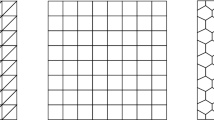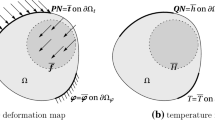Abstract
A virtual element discretisation for the numerical approximation of the three-field formulation of linear poroelasticity introduced in R. Oyarzúa and R. Ruiz-Baier, (SIAM J. Numer. Anal. 54 2951–2973, 2016) is proposed. The treatment is extended to include also the transient case. Appropriate poroelasticity projector operators are introduced and they assist in deriving energy bounds for the time-dependent discrete problem. Under standard assumptions on the computational domain, optimal a priori error estimates are established. These estimates are valid independently of the values assumed by the dilation modulus and the specific storage coefficient, implying that the formulation is locking-free. Furthermore, the accuracy of the method is verified numerically through a set of computational tests.
Similar content being viewed by others
References
Ahmad, B., Alsaedi, A., Brezzi, F., Marini, L.D., Russo, A.: Equivalent projectors for virtual element methods. Comput. Math. Appl. 66, 376–391 (2013)
Ahmed, E., Nordbotten, J.M., Radu, F.A.: Adaptive asynchronous time-stepping, stopping criteria, and a posteriori error estimates for fixed-stress iterative schemes for coupled poromechanics problems. J. Comput. Appl. Math. 364, 112312 (2020)
Anaya, V., Bendahmane, M., Mora, D., Sepúlveda, M.: A virtual element method for a nonlocal FitzHugh-Nagumo model of cardiac electrophysiology. IMA J.Numer.Anal. 40(2), 1544–1576 (2020)
Anaya, V., De Wijn, Z., Gómez-Vargas, B., Mora, D., Ruiz Baier, R.: Rotation-based mixed formulations for an elasticity-poroelasticity interface problem. SIAM J.Sci.Comput. 42(1), B225–B249 (2020)
Antonietti, P.F., Beirão da Veiga, L., Mora, D., Verani, M.: A stream virtual element formulation of the Stokes problem on polygonal meshes. SIAM J.Numer.Anal. 52, 386–404 (2014)
Antonietti, P.F., Beirão da Veiga, L., Scacchi, S., Verani, M.: A c1 virtual element method for the Cahn–Hilliard equation with polygonal meshes. SIAM J. Numer. Anal. 54, 36–56 (2016)
Arega, F., Hayter, E.: Coupled consolidation and contaminant transport model for simulating migration of contaminants through the sediment and a cap. Appl. Math. Model. 32, 2413–2428 (2008)
Asadi, R., Ataie-Ashtiani, B., Simmons, C.T.: Finite volume coupling strategies for the solution of a Biot consolidation model. Comput. Geotech. 55, 494–505 (2014)
Beirão da Veiga, L., Brezzi, F., Cangiani, A., Manzini, G., Marini, L.D., Russo, A.: Basic principles of virtual element methods. Math.Models Methods Appl.Sci. 23, 199–214 (2013)
Beirão da Veiga, L., Brezzi, F., Marini, L.D., Russo, A.: Virtual element method for general second-order elliptic problems on polygonal meshes. Math. Models Methods Appl. Sci. 26, 729–750 (2016)
Beirão da Veiga, L., Lovadina, C., Vacca, G.: Divergence free virtual elements for the Stokes problem on polygonal meshes. ESAIM: Math. Model. Numer. Anal. 51, 509–535 (2017)
Beirão da Veiga, L., Mora, D.: A mimetic discretization of the Reissner-Mindlin plate bending problem. Numer. Math. 117, 425–462 (2011)
Beirão da Veiga, L., Mora, D., Rivera, G.: Virtual Elements for a shear-deflection formulation of Reissner-Mindlin plates. Math. Comp. 88, 149–178 (2019)
Boffi, D., Botti, M., Di Pietro, D.A.: A nonconforming high-order method for the Biot problem on general meshes. SIAM J.Sci.Comput. 38, A1508–A1537 (2016)
Borregales, M., Radu, F.A., Kumar, K., Nordbotten, J.M.: Robust iterative schemes for nonlinear poromechanics. Comput. Geosci 22, 1021–1038 (2018)
Both, J.W., Borregales, M., Nordbotten, J.M., Kumar, K., Radu, F.A.: Robust fixed stress splitting for Biot’s equations in heterogeneous media. Appl. Math. Lett. 68, 101–108 (2017)
Botti, L., Botti, M., A. Daniele Di Pietro: An abstract analysis framework for monolithic discretisations of poroelasticity with application to Hybrid High-Order methods, Comput.Math.Appl. (Available onlne:https://doi.org/10.1016/j.camwa.2020.06.004) (2020)
Brenner, S.C., Guan, Q., Sung, L.Y.: Some estimates for virtual element methods. Comput. Methods Appl Math. 17, 553–574 (2017)
Brenner, S.C., Scott, L.R.: The mathematical theory of finite element methods. In: Texts in Applied Mathematics, Springer, New York. xviii+ 397pp (2008)
Cáceres, E., Gatica, G. N.: A mixed virtual element method for the pseudostress-velocity formulation of the Stokes problem. IMA J. Numer. Anal. 37, 296–331 (2017)
Cangiani, A., Georgoulis, E.H., Pryer, T., Sutton, O.J.: A posteriori error estimates for the virtual element method. Numer.Math. 137, 857–893 (2017)
Cangiani, A., Manzini, G., Sutton, O.J.: Conforming and nonconforming virtual element methods for elliptic problems. IMA J.Numer.Anal. 37, 1317–1354 (2017)
Coulet, J., Faille, I., Girault, V., Guy, N., Nataf, F.: A fully coupled scheme using virtual element method and finite volume for poroelasticity. Comput.Geosci. 24, 381–403 (2020)
Fu, G.: A high-order HDG method for the Biot’s consolidation model. Comput.Math.Appl. 77, 237–252 (2019)
Gaspar, F.J., Lisbona, F.J. and Vabishchevich, P.N.: Finite difference schemes for poroelastic problems. Comput.Methods Appl.Math. 2, 132–142 (2002)
Girault, V., Pencheva, G., Wheeler, M.F., Wildey, T.: Domain decomposition for poroelasticity and elasticity with DG jumps and mortars. Math. Models methods appl Sci. 21, 169–213 (2011)
Girault, V., Raviart, P.-A.: Finite Element Methods for Navier-Stokes Equations: Theory and algorithms. Springer Series in Computational Mathematics. (5) x + 374pp (1986)
Holden, H., Karlsen, K.H., Lie, K.A., Risebro, N.H.: Splitting Methods for Partial Differential Equations with Rough Solutions: Analysis and MATLAB programs. European Mathematical Society (2010)
Hong, Q., Kraus, J.: Parameter-robust stability of classical three-field formulation of Biot’s consolidation model. Electron. Trans. Numer. Anal. 48, 202–226 (2018)
Hu, X., Rodrigo, C., Gaspar, F.J., Zikatanov, L.T.: A non-conforming finite element method for the Biot’s consolidation model in poroelasticity. J. Comput. Appl. Math. 310, 143–154 (2017)
Kim, J., Tchelepi, H.A., Juanes, R.: Stability, accuracy and efficiency of sequential methods for coupled flow and geomechanics. SPE J. 16(02), 119084 (2011)
Kolesov, A.E., Vabishchevich, P.N., Vasilyeva, M.V.: Splitting schemes for poroelasticity and thermoelasticity problems. Comput. Math. Appl. 67, 2185–2198 (2014)
Kumar, S., Oyarzúa, R., Ruiz-Baier, R., Sandilya, R.: Conservative discontinuous finite volume and mixed schemes for a new four-field formulation in poroelasticity. ESAIM: Math.Model.Numer.Anal. 54(1), 273–299 (2020)
Lee, J.J.: Analysis and preconditioning of parameter-robust finite element methods for Biot’s consolidation model. arXiv:1806.11566
Lee, J.J., Mardal, K.-A., Winther, R.: Parameter-robust discretization and preconditioning of Biot’s consolidation model. SIAM J.Sci.Comput. 39, A1–A24 (2017)
Lee, J.J.: Robust three-field finite element methods for Biot’s consolidation model in poroelasticity. Bit Numer Math 58, 347–372 (2018)
Lee, J.J., Piersanti, E., Mardal, K.-A., Rognes, M.: A mixed finite element method for nearly incompressible multiple-network poroelasticity. SIAM J.Sci.Comput. 41, A722–A747 (2019)
Mauck, R.T., Hung, C.T., Ateshian, G.A.: Modelling of neutral solute transport in a dynamically loaded porous permeable gel: implications for articular cartilage biosynthesis and tissue engineering. J. Biomech. Engrg. 125, 602–614 (2003)
Mikelić, A., Wang, B., Wheeler, M.F.: Numerical convergence study of iterative coupling for coupled flow and geomechanics. Comput. Geosci. 18, 325–34 (2014)
Mikelić, A., Wheeler, M.F.: Convergence of iterative coupling for coupled flow and geomechanics. Comput. Geosci. 17, 455–461 (2013)
Mora, D., Rivera, G.: A priori and a posteriori error estimates for a virtual element spectral analysis for the elasticity equations. IMA J.Numer.Anal. 40(1), 322–357 (2020)
Mora, D., Rivera, G., Rodríguez, R.: A virtual element method for the Steklov eigenvalue problem. Math. Models Methods Appl.Sci. 25, 1421–1445 (2015)
Murad, M.A., Thomée, V., Loula, A.F.D.: Asymptotic behavior of semi discrete finite-element approximations of Biot’s consolidation problem. SIAM J.Numer.Anal. 33, 1065–1083 (1996)
Naumovich, A.: On finite volume discretization of the three-dimensional Biot poroelasticity system in multilayer domains. Comput. Methods Appl.Math. 6, 306–325 (2006)
Oyarzúa, R., Ruiz-Baier, R.: Locking-free finite element methods for poroelasticity. SIAM J.Numer.Anal. 54, 2951–2973 (2016)
Perugia, I., Pietra, P., Russo, A.: A plane wave virtual element method for the Helmholtz problem. ESAIM Math. Model. Numer. Anal. 50, 783–808 (2016)
Rivière, B., Tan, J., Thompson, T.: Error analysis of primal discontinuous Galerkin methods for a mixed formulation of the Biot equations. Comput.Math.Appl. 73, 666–683 (2017)
Showalter, R.E.: Diffusion in poro-elastic media. J. Math. Anal. Appl. 251, 310–340 (2000)
Tang, X., Liu, Z., Zhang B., Feng, M.: On the locking-free three-field virtual element methods for Biot’s consolidation model in poroelasticity, ESAIM: Math.Model.Numer.Anal. (Available online:https://doi.org/10.1051/m2an/2020064) (2020)
Vacca, G.: An h1-conforming virtual element for Darcy and Brinkman equations. Math. Models Methods Appl.Sci. 28, 159–194 (2018)
Vacca, G., Beirão da Veiga, L.: Virtual element methods for parabolic problems on polygonal meshes. Numer. Methods Partial Differential Equations 31, 2110–2134 (2015)
Verma, N., Gómez-Vargas, B., De Oliveira Vilaca, L.M. , Kumar, S., Ruiz-Baier, R.: Well-posedness and discrete analysis for advection-diffusion-reaction in poroelastic media. Applic. Anal. in press (2020)
Yi, S.-Y.: A coupling of nonconforming and mixed finite element methods for Biot’s consolidation model. Numer. Methods Partial Differential Equations 29(5), 1749–1777 (2013)
Yi, S.-Y.: A study of two modes of locking in poroelasticity. SIAM J.Numer.Anal. 55, 1915–1936 (2017)
Acknowledgements
We thank the valuable comments by two anonymous reviewers, whose suggestions led to numerous improvements to the manuscript.
Funding
This work has been partially supported by CONICYT (Chile) through projects FONDECYT 1170473, FONDECYT 1180913, CMM, project ANID/PIA/AFB170001, and CRHIAM, project ANID/FONDAP/15130015; by the HPC-Europa3 Transnational Access Grant HPC175QA9K; and by the Department of Science and Technology (DST-SERB), India through MATRICS grant MTR/2019/000519.
Author information
Authors and Affiliations
Corresponding author
Additional information
Communicated by: Lourenco Beirao da Veiga
Publisher’s note
Springer Nature remains neutral with regard to jurisdictional claims in published maps and institutional affiliations.
Appendix 1: Proof of Theorem 4.3
Appendix 1: Proof of Theorem 4.3
As in the semi-discrete case, we split the individual errors as
Then, from estimate (4.2a) and following the steps of the proof of Theorem 4.2, we get the bounds:
From Eqs. 4.1a, 3.17a, and 2.3a, we readily get:
We then use Eqs. 4.1b and 3.21, and proceed to differentiate (2.3c) with respect to time. This implies
After choosing \(\boldsymbol {v}_{h} = E_{\boldsymbol {u}}^{A,n} - E_{\boldsymbol {u}}^{A,n-1 } \) in Eq. A.2 and \(\phi _{h} = - E_{\psi }^{A,n}\) in Eq. A.3 and adding the outcomes, we readily get:
Next, and as a consequence of using Eqs. 4.1c, 3.7b, and 2.3b with \(q_{h} = E_{p}^{A,n}\), we are left with
If we then add the resulting (A.4)–(A.5) and repeat the same arguments used in deriving (3.11), we can assert that
The left-hand side can be bounded by using the inequality (3.24) and then summing over n we get:
We bound the term L1 with the help of formula (3.25), the estimates of projection \(\boldsymbol \varPi ^{0,0}_{K}\), applying Taylor expansion, and using generalised Young’s inequality. This gives
Then, the estimate satisfied by the projection \({\varPi ^{0}_{K}}\) along with Poincaré and Young’s inequalities yields:
The discrete inf-sup condition (3.6) implies that
Applying an expansion in Taylor series, together with Eq. A.6, the Cauchy-Schwarz, and Young inequalities, enables us to write
Then, after using the estimates of the projection \({I_{p}^{h}}\) (4.2b), (A.6), and applying again Cauchy-Schwarz inequality, we get
The stability of a3(⋅,⋅) and the proof for the bound of L4 gives
The polynomial approximation pπ for fluid pressure, consistency of the bilinear form \(\tilde {a}_{2}^{h}(\cdot , \cdot )\), stability of the bilinear forms \(\tilde {a}_{2}(\cdot , \cdot ), \tilde {a}_{2}^{h}(\cdot , \cdot )\), and the Cauchy-Schwarz, Poincaré and Young’s inequalities gives
The continuity of b2(⋅,⋅), the bound derived for the term L5 and using the Young’s inequality, gives
In turn, putting together the bounds obtained for all Li’s, \(i=1, \dots , 7\), using the Young’s inequality and Lemma 3.2 concludes that
And finally, the desired result (4.9) holds after choosing \({\boldsymbol {u}_{h}^{0}}: =\boldsymbol {u}_{I}(0)\), \({\psi _{h}^{0}}: = \varPi ^{0,0}\psi (0)\), \({p_{h}^{0}}: = p_{I}(0)\) and applying triangle’s inequality together with Eqs. 1– 3, and A.6.
Rights and permissions
About this article
Cite this article
Bürger, R., Kumar, S., Mora, D. et al. Virtual element methods for the three-field formulation of time-dependent linear poroelasticity. Adv Comput Math 47, 2 (2021). https://doi.org/10.1007/s10444-020-09826-7
Received:
Accepted:
Published:
DOI: https://doi.org/10.1007/s10444-020-09826-7




